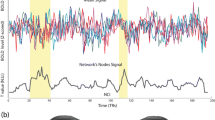Abstract
Negative and arousal-inducing film clips were used to assess the neural correlates of emotional expression and suppression. Compared to viewing neutral clips, both negative (disgusting) and arousal (action) clips activated primarily posterior regions in the parietal and occipital cortex when participants were instructed to express their emotions. When instructed to suppress their emotions while viewing negative clips, a broad frontoparietal network was activated that included lateral, medial, and orbital regions in the prefrontal cortex as well as lateral and medial regions of the posterior parietal cortex. The suppression of arousal clips also activated prefrontal and parietal regions, though not to the same extent as the suppression of negative clips. The findings demonstrate the potency of using movies to engage emotional processes and highlight a broad frontoparietal network that is engaged during the suppression of negative film clips.



Similar content being viewed by others
References
Anderson, L., & Shimamura, A. P. (2005). Influences of emotion on context memory while viewing film clips. The American Journal of Psychology, 118, 323–337.
Baldo, J. V., Shimamura, A. P., Delis, D. C., Kramer, J., & Kaplan, E. (2001). Verbal and design fluency in patients with frontal lobe lesions. Journal of the International Neuropsychological Society, 7, 586–596.
Beauregard, M., Levesque, J., & Bourgouin, P. (2001). Neural correlates of conscious self-regulation of emotion. Journal of Neuroscience, 21, 6993–7000.
Berkman, E. T., & Lieberman, M. D. (2009). Using neuroscience to broaden emotion regulation: Theoretical and methodological considerations. Social and Personality Compass, 3, 475–493.
Buckner, R. L., Andrews-Hanna, J. R., & Schacter, D. L. (2008). The brain’s default network: Anatomy, function, and relevance to disease. Annals of the New York Academy of Science, 1124, 1–38.
Denny, B., Silvers, J., & Ochsner, K. N. (2010). How we heal what we don’t want to feel: The functional neural architecture of emotion regulation. In A. M. Kring & D. M. Sloan (Eds.), Emotion regulation and psychopathology: A transdiagnostic approach to etiology and treatment (pp. 59–87). New York: Guilford Press.
Goldin, P. R., McRae, K., Ramel, W., & Gross, J. J. (2008). The neural bases of emotion regulation: Reappraisal and suppression of negative emotion. Biological Psychiatry, 63, 577–586.
Goodkind, M. S., Gyurak, A., McCarthy, M., Miller, B. L., & Levenson, R. W. (2010). Emotion regulation deficits in frontotemporal lobar degeneration and alzheimer’s disease. Psychology and Aging, 25, 30–37.
Gross, J. J., Sheppes, G., & Urrey, H. L. (2011). Emotion generation and emotion regulation: A distinction we should make (carefully). Cognition and Emotion, 25, 765–781.
Gyurak, A., Goodkind, M. S., Kramer, J. H., Miller, B. L., & Levenson, R. W. (2012). Executive functions and the down-regulation and up-regulation of emotion. Cognition & Emotion, 26, 103–118.
Hornberger, M., Geng, J., & Hodges, J. R. (2011). Convergent grey and white matter evidence of orbitofrontal cortex changes related to disinhibition in behavioural variant frontotemporal dementia. Brain, 134, 2502–2512.
Jackson, D. C., Malmstadt, J. R., Larson, C. L., & Davidson, R. J. (2000). Suppression and enhancement of emotional responses to unpleasant pictures. Psychophysiology, 37, 515–522.
Kober, H., Barrett, L. F., Joseph, J., Bliss-Moreau, E., Lindquist, K., & Wager, T. D. (2008). Functional grouping and cortical-subcortical interactions in emotion: A meta-analysis of neuroimaging studies. NeuroImage, 42, 998–1031.
Kolodyazhniy, V., Kreibig, S. D., Gross, J. J., Roth, W. T., & Wilhelm, F. H. (2011). An affective computing approach to physiological emotion specificity: Toward subject-independent and stimulus-independent classification of film induced emotions. Psychophysiology, 48, 908–922.
LaBar, K. S., Crupain, M. J., Voyvodic, J. T., & McCarthy, G. (2003). Dynamic perception of facial affect and identity in the human brain. Cerebral Cortex, 13, 1023–1033.
Macmillan, M. (2000). An Odd kind of fame: Stories of phineas gage. Cambridge: MIT Press.
McRae, K., Hughes, B., Chopra, S., Gabrieli, J. D. E., Gross, J. J., & Ochsner, K. N. (2009). The neural bases of distraction and reappraisal. Journal of Cognitive Neuroscience, 22, 248–262.
Mital, P. K., Smith, T. J., Hill, R. L., & Henderson, J. M. (2011). Clustering of gaze during dynamic scene viewing is predicted by motion. Cognitive Computation, 3, 5–24.
Ochsner, K. N., Bunge, S. A., Gross, J. J., & Gabrieli, J. D. E. (2002). Rethinking feelings: An fMRI study of the cognitive regulation of emotion. Journal of Cognitive Neuroscience, 14, 1215–1229.
Ochsner, K. N., Ray, R. D., Cooper, J. C., Robertson, E. R., Chopra, S., Gabrieli, J. D. E., & Gross, J. J. (2004). For better or for worse: Neural systems supporting the cognitive down- and up-regulation of negative emotion. NeuroImage, 23, 483–499.
Rule, R. R., Shimamura, A. P., & Knight, R. T. (2002). Orbitofrontal cortex and dynamic filtering of emotional stimuli. Cognitive, Affective, & Behavioral Neuroscience, 2, 264–270.
Shimamura, A. P. (Editor) (in press). Psychocinematics: Exploring Cognition at the Movies. New York: Oxford University Press.
Urrey, H. L., vanReekum, C. M., Johnstone, T., Kalin, N. H., Thurow, M. E., Schaefer, H. S., et al. (2006). Amygdala and ventromedial prefrontal cortex are inversely coupled during regulation of negative affect and predict the diurnal pattern of cortisol secretion among older adults. Journal of Neuroscience, 26, 4415–4425.
Wright, P., He, G., Shapira, N. A., Goodman, W. K., & Liu, Y. (2004). Disgust and the insula: fMRI responses to pictures of mutilation and contamination. NeuroReport, 15, 2347–2351.
Zacks, J. M., Speer, N. K., Swallow, K. M., & Maley, C. J. (2010). The brain’s cutting-room floor: Segmentation of narrative cinema. Frontiers in Human Neuroscience, 4, 1-15.
Acknowledgments
Research was supported by NIH Grants DA14110 and NS17778. We thank Ken Iwasaki and Ari Kane for research assistance.
Author information
Authors and Affiliations
Corresponding author
Rights and permissions
About this article
Cite this article
Shimamura, A.P., Marian, D.E. & Haskins, A.L. Neural correlates of emotional regulation while viewing films. Brain Imaging and Behavior 7, 77–84 (2013). https://doi.org/10.1007/s11682-012-9195-y
Published:
Issue Date:
DOI: https://doi.org/10.1007/s11682-012-9195-y




